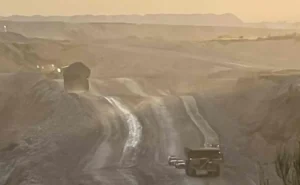The federal government is spending the first $200 million from its critical industries fund on greening steelworks in Port Kembla and Whyalla.
Bluescope Steel will get $135.8 million to reline and upgrade its No. 6 blast furnace at the Port Kembla Steelworks in New South Wales (NSW) from the Powering the Regions Fund (PRF), which without a renovation will reach the end of its life by 2030.
The remaining $63.2 million is to businessman Sanjeev Gupta’s Liberty Steel Australia, which will buy and commission a low carbon electric arc furnace (EAF) to replace an existing traditional blast furnace at the Whyalla Steelworks. The new EAF will support the manufacturing of green steel.
“Now is the time to phase out increasingly obsolete equipment and technology that no longer has a place in our world and embrace the installation of new EAF technology that ensures environmentally sustainable steel production in Whyalla will continue throughout the 21st century,” Gupta says.
He says the company is looking at renewable energy and other green technologies as well for the steelworks, including locally produced green hydrogen.
Liberty’s shift to green iron and steel will increase its workforce by around 24 per cent over five years and provide retraining opportunities for many existing employees. Bluescope will need an extra 250 people to handle the refitting.
The PRF grants are the first to come from the $400 million Critical Inputs to Clean Energy Industries program, which supports hard-to-abate sectors like steel and was developed following the Safeguard Mechanism reforms.
The government’s priority for industries like steel is to keep them running as consumers and investors demand better efforts on decarbonisation, said energy minister Chris Bowen at a press conference today in Port Kembla.
“A serious country makes things, and a serious country makes steel. And as far as we’re concerned, as long as we have a say in it… Australia will be an important country making steel and, as I said, steel that is vital for our renewable energy transformation,” he says.
“Our renewable energy transformation will require 5 billion tonnes of steel between now and 2050 across the world.
“We want to make sure products vital to our economic future like green steel are made in Australia, but this will require innovation and new ways of processing iron ore that decarbonise our steel industry.
“This $200 million investment in the steel sector is about securing the long-term future of the steel industry in Australia.”
The federal government has also committed $200 million in grant funding for projects in the cement, lime, alumina and aluminium sectors, with successful applicants to be announced in the coming months.
Funding shows challenge in greening steel
Although emissions reduction is core to the $1.9 billion PRF, the two grants show how difficult it will be to decarbonise industries like steelmaking.
Liberty said in April last year that it had ordered a 160 tonne EAF for the Whyalla steelworks and it should be operational by 2025.
And in September it announced – with a prime ministerial visit – that it had closed the Whyalla coke ovens with which it’d made the coal it needed for the blast furnaces. However, the company is still using imported metallurgical coal while it waits for the EAF.
“Whyalla will be the global epicentre for manufacturing low carbon iron and steel, it has all the elements required to dominate the green steel industry – vast reserves of magnetite of the highest quality, abundant generation of renewable energy, deep sea port, a robust workforce, supportive governments and invested owners,” Gupta says.
Bluescope’s rejuvenated coal-fired blast furnace will not deliver green steel but it does promise emissions reductions of up to 172,000 tCO2-e per year.
In documents lodged with the NSW Department of Planning and Transport, Bluescope said the upgrades include a top gas recovery turbine to generate electricity, installation of dual lances at the tuyerestock to enable the use of alternative reductants such as hydrogen-rich coke ovens gas and renewable hydrogen, and installation of a waste gas heat recovery system to reduce fuel consumption at the stoves and liberate coke ovens gas for injection into the furnace (through the new lances).
The company said in August, when the $1.15 billion project was approved by the board, that it “does not lock us into a full 20-year blast furnace campaign”.
Today, Bowen was questions by journalists about the same issue.
“What we don’t want to see and what we won’t let see is other countries making steel without the sort of carbon constraints that we have in Australia and Australian competitiveness being impacted. So hence, we worked very carefully to design the safeguard mechanism to reduce emissions on site but also to protect those trade-exposed, emissions-intensive industries like steel-making,” he said in reply.
Bluescope CEO of steel products, Tania Archibald, said the refit will keep the Port Kembla steelworks operating while the company looks for lower emissions alternative — like direct reduced iron (DRI) technology which uses gas.
Archibald says DRI is the most promising technology to decarbonise steel. It can reduce emissions by 60-85 per cent. But the company decided against using it as it couldn’t source cheap gas.
The reconditioned blast furnace is expected to be commissioned in mid-to-late 2026.
The grant funding will help Bluescope to secure thousands of jobs in the area, says local member Alison Byrnes.
“Steel is vital to achieving our renewable energy transition and for the construction of new housing and the Illawarra is a crucial player in these national objectives,” she says.
Liberty aims to be carbon neutral by 2030, while Bluescope’s goal is net zero by 2050.
*This article has been updated with Bluescope’s expected emissions reductions from the blast furance upgrade.










